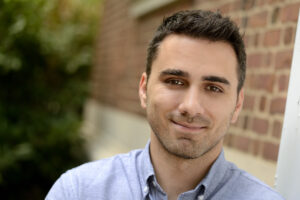Feb 6, 2023 | No Comments | By Salena Fitzgerald
Stavros Gaitanaros’ innovative research focuses on the mechanics of “architected materials” – a a class of materials with exceptional mechanical, acoustic, and thermal properties and unlimited potential in a variety of applications, from space structures and energy storage devices to biomedical implants.
In the interview below, the assistant professor in the Department of Civil and Systems Engineering, fellow in the Hopkins Extreme Materials Institute and the Johns Hopkins Center for Additive Manufacturing and Architected Materials (JAM2), and leader of the Extreme Mechanics of Architected Materials group, shares thoughts on his field, his research program, and the future.
What are the most important problems in your field today?
A wide range of global challenges, from space exploration to modern infrastructure and health, require the design and discovery of new materials with multiple functionalities that provide resilience and sustainability.
Which of those problems are you tackling through your research, and why did you choose them?
My research focuses on novel lightweight materials with excellent combinations of mechanical, acoustic, and thermal properties, that are derived by the underlying material architecture – a combination of geometry and distribution of matter. Architected materials are characterized by their mesostructure, meaning their morphological features are larger than the atomic scale but still small enough to be classified as a material (one can think of a sponge). Varying the geometric features of this mesostructure and combining them with any typical solid leads to a plethora of material systems with distinct behavior, in a similar manner to material scientists using chemistry and the periodic table to create new alloys. It is actually a concept that nature employs to generate all of its essential structures, from honeycombs and bone to wood and plant stems. It is this unique combination of geometric design and mechanics, applied to both biological and engineered materials, that drew me to this field.
Does your current research seek to answer a fundamental question in science, or does it have potential practical ramifications? Tell us more about that.
My research group is particularly interested in the extreme mechanics of architected materials, which entails their response under large deformations–how they fail, how much energy they can absorb under impact loads, how waves propagate through them, or how they collapse under high temperatures. Our work aims to advance our fundamental understanding of architected materials and develop the necessary computational tools that will enable their systematic design and analysis. Our findings have a far-reaching impact on a broad spectrum of engineering applications, from resilient space structures to soft scaffolds for tissue engineering.
How is your approach to the problem better, more innovative, more promising, or just different than the approach others in your field are using?
The effective blend of different techniques including geometric design, additive manufacturing, computational modeling, theory, and, as of recently, data-driven methods, defines the identity of our group and our unique approach to solving these complex problems.
What has been your most significant finding so far? How about your most surprising finding?
Quantifying significance is tough so I will borrow a passage from Leo Tolstoy’s diaries instead: “There is only one significance, you are a worker. The assignment is inscribed in your reason and heart and expressed clearly and comprehensibly by the best among the beings similar to you. The reward for doing the assignment is immediately within you. But what the significance of the assignment is or of its completion, that you are not given to know, nor do you need to know it. It is good enough as it is. What else could you desire?”
A surprising finding, or at least counterintuitive at first, is that a certain amount of disorder in materials is almost always beneficial (the philosophical extrapolation is rather amusing…).
What other engineer or scientist in your field has influenced you? How?
If I had to choose one, it would be Theodore Von Karman for his enormous body of work in fluid and solid mechanics, and the way he integrated (if not transcended) engineering, applied mathematics, and physics. He is mostly known for his work on aerodynamics but his studies on the mechanics and instabilities of thin plates and shells are, in my opinion, equally important. I would urge any engineering student to find his paper “The engineer grapples with nonlinear problems” or even better read one of his books (if the 5-volume collected works of his seems too heavy of a task). Von Karman is also an academic ancestor of mine, so I have to acknowledge some level of bias in my choice.
Do you expect to continue working on the same problem five years from now? How about 10? If not, what other research avenues do you anticipate exploring?
My long-term to-do list involves a bunch of diverse problems, from seismic metamaterials and plant mechanics to physics of bubbles, that I really hope I’ll get to explore in the future.
Anything else you want to add?
This Q&A was harder than I initially thought, like a Marcel Proust questionnaire tailored for scientists!

This Q&A was excerpted from the Department of Civil & Systems Engineering. You can read the complete story here.




Leave a Reply